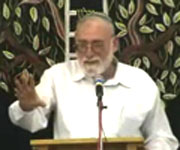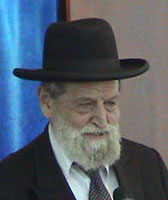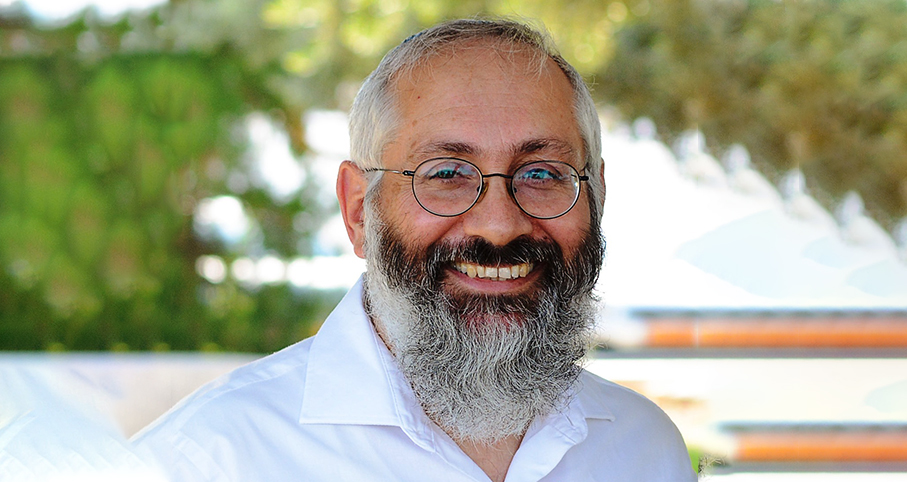Beit Midrash
- Torah Portion and Tanach
- D'varim
- Vayelech
In parshas Vayechi, Yehudah is blessed by his father Yaakov: "The scepter will not depart from Yehudah, nor will the lawmaker [depart] from his descendants, even when Shiloh [Moshiach] arrives. To him will the nations gather" (Bereishis 49:10). Some explain the pasuk in the following way: "Both the monarchy and the teaching of Torah will remain among the descendants of Yehudah, both in the short term, and certainly when Moshiach (Shiloh) arrives. Also, he will be the one who teaches the Jewish people when they gather every seven years for hakheil." Thus, the blessing received by Yehudah is: Dovid Hamelech and the royal Jewish family will be his descendants, they will reign over the Jewish people, both early in Jewish history as the monarchs of the Kingdom of Judea; later, for a thousand years in Bavel, under the title of Reish Gelusa; and then, eventually, for the rest of history, when Moshiach rules over the Jewish people and, indirectly, over the entire world.
One of the manifestations of this rule will be the mitzvah of hakheil, when the entire Jewish people -- men, women, and even babies -- gather to the grounds of the Beis Hamikdash to hear the king of the Jewish people read selections of the book of Devorim to the entire nation.This was done on Chol Hamoed Sukkos in the year following shemittah (see Devorim 31:10-13 and Mishnah, Sotah 41a). Indeed, one of Shelomoh Hamelech’s names is Koheles, because of his central role in the mitzvah of hakheil. Similarly, we have a Biblical allusion to the fulfillment of this mitzvah by Yoshiyahu Hamelech in Divrei Hayamim (2:34:29-33).
Questions:
With this introduction, let us examine the following questions:
What exactly is done at hakheil?
When is hakheil performed?
Why was hakheil not observed on Shabbos?
Who is obligated to attend hakheil?
Was the reading of hakheil performed only by kings of the house of Dovid?
Is hakheil one mitzvah or two?
What is done at hakheil?
Hakheil is a public gathering and ceremony whose focal point is a kerias haTorah read by the king of the Jewish people on the grounds of the Beis Hamikdash. When we have a Beis Hamikdash, bimheirah veyameinu, this mitzvah will again be performed. The king of the Jews will read selections of the book of Devorim from a special sefer Torah kept in the Beis Hamikdash area.
The procedure
As reported by the Tosefta (a source of halachah dating back to the era of the Mishnah), prior to the reading, "a wood platform was constructed in the Azarah (an inner section of the Beis Hamikdash), and the king sat upon it" (Tosefta, Sotah 7:8). The fact that anyone was permitted to sit in the Azarah area was unique, because no one other than a king of the line of Dovid Hamelech was ever permitted to sit in the Azarah or any of the holier sections of the Beis Hamikdash (Yoma 25a et al.). This halachah is derived from a verse in the Book of Shemuel (2:7:18).
According to an alternative opinion quoted by the Tosefta, the platform was constructed on the Har Habayis, the Temple Mount area, which is outside the Beis Hamikdash, and, therefore, anyone may sit there. Thus, we have a dispute whether hakheil was performed in the Beis Hamikdash itself, or right outside. Either way, the area where hakheil is performed requires that all the people who attend be tehorim, ritually pure as defined by halachah.
The kohanim and hakheil
As should be appropriate for a public reading of the sefer Torah, there was much pomp and circumstance preceding the mitzvah of hakheil. To continue the Tosefta: "On that day, the kohanim stood on the fences (of Yerushalayim), and in the breaches (between the fences), holding golden bugles. (I translated the word chatzotzeres as bugle, because trumpets that use valves or keys were not invented until relatively recently. The word trumpet used to mean an instrument that had no valves, but today all trumpets have valves.) They blew tekiah, teruah, tekiah. People said that any kohen who was not holding a bugle might be accused of being an imposter. The people of Yerushalayim made considerable money by renting the golden bugles at the price of a golden dinar each." The kohanim’s blowing was to make sure everyone remembered to come for hakheil, somewhat reminiscent of the soundtrucks that blast their way through Yerushalayim to announce everything from funerals, sifrei Torah dedications, and tzedakah collections to sales and chol hamoed entertainment.
There is a question here about the bugles, because the Torah requires that chatzotzeros be manufactured from silver, not gold. Why should inviting people for hakheil require gold bugles?
I was told an answer in the name of Rav Avraham Sherman, a prominent dayan in Eretz Yisroel, that the chatzotzeros for hakheil were, indeed, made of silver, not gold. They were called the "golden chatzotzeros" not because they were made of gold, but because the rental fee was charged in gold, as the Tosefta states.
Taking out the sefer Torah
The sefer Torah was taken out with much ceremony, as should always be done. On the occasion of hakheil, the sefer Torah was first brought by the gabbai, called the chazzan hakenesses, who then handed it to a higher official, called the rosh hakenesses. In turn, the rosh hakenesses handed the sefer Torah to the segan, the associate kohen gadol, who handed it to the kohen gadol, who then handed the sefer Torah to the king. The king received the sefer Torah while standing and then sat down to read, which, as we mentioned above, was a special prerogative allowed only to kings who were descendants of Dovid Hamelech (Sotah 41a). The king recited a brocha as we do before the reading when we receive an aliyah. He was the only person to receive an aliyah for this reading, and he himself read the Torah. After the reading, he recited a series of eight brachos (Sotah 40b-41a).
Date of hakheil
When exactly is hakheil performed?
Actually, there are two versions of the Mishnah as to exactly on which date hakheil took place. According to the more common text, hakheil was performed on the first day of chol hamoed Sukkos, or, in the words of the Mishnah, motza’ei Yom Tov harishon shel chag, the sixteenth of Tishrei (which corresponds to the second day of Yom Tov in chutz la’aretz). However, there is another text that reads motza’ei Yom Tov ha’acharon shel chag (cited by Yerushalmi, Sotah, and Rashi, Megillah 5a). According to this text, hakheil occurred on isru chag, the day after Yom Tov, the 23 rd of Tishrei. (This date corresponds to the date celebrated in chutz la’aretz as Simchas Torah.) From the wording of the Rambam (Hilchos Chagigah 3:1), it appears that one could fulfill the mitzvah either way, although he rules that one should perform hakheil at the beginning of Chol Hamoed.
Hakheil on Shabbos
The Mishnah (Megillah 5a) notes that sometimes hakheil was postponed. When and why was it postponed? The Gemara Yerushalmi and Rashi explain that when the preferred day for hakheil (which was the day after either the first or last day of Sukkos) fell on Shabbos, hakheil was postponed to the next day.
But, check your calendar -- neither the second day of Sukkos, the 16 th of Tishrei, nor the 23 rd of Tishrei can ever fall on Shabbos! Since this can occur only if Rosh Hashanah were to fall on a Friday, this violates the calendar rule of lo adu rosh, that the first day of Rosh Hashanah can never fall on Sunday, Wednesday or Friday.
The answer to this question is historical. The mitzvah of hakheil was observed while the Beis Hamikdash stood, which was prior to the establishment of our current calendar. Our contemporary Jewish calendar was instituted by Hillel Hanasi, the great-grandson of Rabbi Yehudah Hanasi (not to be confused with Hillel Hazakein, who was their ancestor), about 250 years after the destruction of the second Beis Hamikdash (Rambam, Hilchos Kiddush Hachodesh 5:3). In our current calendar, the second day of Sukkos cannot fall on Shabbos. However, prior to Hillel Hanasi, the Jewish calendar was determined by the Sanhedrin, and Rosh Hashanah, Sukkos and all other holidays could fall on any day of the week. When Rosh Hashanah and Sukkos fell on Friday, the first day of chol hamoed and isru chag in Eretz Yisroel would fall on Shabbos. It is this situation that the Mishnah is discussing.
Never on Saturday
Why was hakheil not observed on Shabbos?
Several reasons are provided:
1. As I mentioned above, to help the people hear the recital of hakheil, a platform from which the king read the Torah was constructed in the Beis Hamikdash. This platform could not be constructed on Shabbos or Yom Tov. Furthermore, were they to construct it before it was needed, it would have gotten in the way of the crowds that attended the Beis Hamikdash on the yomim tovim. Therefore, if the first day of chol hamoed fell on Shabbos, hakheil was postponed to Sunday, so that the platform could be built that day (Yerushalmi, Megillah 1:4, quoted by Rashi, Megillah 5a).
2. Another opinion, also quoted in the above-mentioned passage of Talmud Yerushalmi, contends that hakheil was postponed from Shabbos so that the bugles could be blown.
3. A third reason is that the people were required to carry their young children to hakheil, which they would have been unable to do on Shabbos (Rashi, Megillah 5a).
Who is obligated to attend hakheil?
The Torah states clearly that "Men, women and children" are obligated in hakheil. Even someone who does not understand any Hebrew is obligated to join the assembly for hakheil (Rambam, Hilchos Chagigah 3:6). Nevertheless, not all men and women are obligated to make the trip to Yerushalayim to hear hakheil. The mitzvah of hakheil does not obligate people who are exempt because of medical reasons from the mitzvah of re’eiah -- the commandment incumbent on all Jewish male adults to come to the Beis Hamikdash and offer korbanos on the three regalim (Pesach, Shevuos, and Sukkos). Therefore, the elderly, the ill, someone who has difficulty walking, one who cannot hear (even if only out of one ear), and someone who cannot see (even if only out of one eye) -- all of whom are exempt from the mitzvah of re’eiah -- are exempt from hakheil (Rambam, Hilchos Chagigah 2:1, 3:2). Many authorities rule that someone who does not own land in Eretz Yisroel is similarly exempt from hakheil (Turei Even, Chagigah 3a s.v. Kedei). However, the Rambam rules that this is not a factor, and that someone who does not own land in Eretz Yisroel is required to observe hakheil.
Someone who is tamei is exempt from coming to hakheil, and, indeed, is forbidden to do so, since he is forbidden to enter the Beis Hamikdash where hakheil was held (Rambam, Hilchos Chagigah 2:1, 3:2).
There is a major difference between the various categories of exemptions from hakheil. People excused from the mitzvah for medical reasons may perform the mitzvah, and if they do so, they will be rewarded as einam metzuvim ve’osim, those who perform a mitzvah that they are not obligated to perform. However, someone who is tamei is forbidden to participate in hakheil, since doing so would cause him to violate the sanctity of the Beis Hamikdash. He should try to make himself tahor as soon as possible.
Unfortunately, in our day, it is very common for people to desecrate this sanctity, as there are groups actively involved in causing and encouraging Jews to ascend Har Habayis, notwithstanding the halachic prohibitions involved.
Which children should hear?
There is a dispute among the acharonim whether every child is required to be brought to hear hakheil, or only children who, when they become adults, will be obligated in the mitzvah. According to this latter opinion, held by the highly respected author of the classic work, Shaagas Aryeh, one is usually not obligated to bring children to hakheil, unless the child already owns his own real estate in Eretz Yisroel (Turei Even, Chagigah 3a s.v. Kedei). However, other, later authorities contend that one is required to bring any minor to the hakheil ceremony (Minchas Chinuch, Mitzvah 612). Indications are that a much earlier authority, the Rambam, held in accordance with the second approach.
House of David?
Could the reading of the hakheil be recited by anyone other than a king of the House of Dovid? The explanation I shared above to interpret Yehudah’s blessing in parshas Vayechi suggests that the hakheil reading could be done by Dovid and his descendants.
However, this approach runs contradictory both to a Mishnah and to a passage of Gemara. The Mishnah teaches that when Agrippas, who was not a descendant of David, was king over the Jews, he read hakheil, although he read it while standing, because he was not of David’s royal line (Sotah 41a). This demonstrates that a Jewish king not from David’s dynasty could read hakheil. Thus, hakheil was performed during the entire period of the second Beis Hamikdash, notwithstanding that there was no king descended from Dovid Hamelech.
Moreover, the following passage of Talmud Yerushalmi implies that someone not descended from malchus beis Dovid could read hakheil, even when there is a king from David’s dynasty!
"Rabbi Yosi ben Yaakov said: Yeravam became king over the Kingdom of Israel in the year after shemittah. He realized that should he arrive in Yerushalayim and demand the honor due him as king, the local gentry of Yerushalayim would contend that the local king (Rechavam, the son of Shelomoh) comes first. Yeravam then said: ‘If I read second, I will feel mortified, and if I do not read at all, it will be a public humiliation. If I allow the people to go on their own to Yerushalayim, they will accept Rechavam, Shelomoh’s son, as king.’ What did Yeravam do? He constructed two golden calves" (Yerushalmi, Avodah Zarah 1:1; see also Sanhedrin 101b). This passage of Yerushalmi explains the events of Melachim I 12-27.
Yeravam was not from the tribe of Yehudah, and yet the Gemara implies that, even with Rechavam, David’s grandson, as Jewish monarch, it would have been appropriate for Yeravam to have read part of the hakheil.
Thus, from the Mishnah and this passage of Gemara we see mitzvas hakheil could be fulfilled even when the Torah was read by someone other than a king descended from Yehudah (Minchas Chinuch).
By the way, the Talmud Bavli (Sanhedrin 101b) recounts the story of Yeravam with a slightly variant version: "We have a tradition that no one may sit in the Azarah area of the Beis Hamikdash but kings who are descended from Yehudah. When the people see Rechavam sitting in the Azarah while I am standing, they will say that he is the king and I am his subject. If, on the other hand, I sit down, they will kill me for rebelling against his monarchy."
Too distant
As mentioned above, almost all of the Jewish people came to hakheil. The number of people was vast, and the king’s voice could carry only so far. How did the people hear him, in the days before the invention of a microphone?
The answer is that one was required to strive to hear the king to the best of one’s ability. If you tried as hard as you could, and you could not hear the reading, you fulfilled the mitzvah (Lechem Mishneh, Hilchos Chagigah 3:6 and Shu"t Igros Moshe, Orach Chayim 1:32).
Is hakheil one mitzvah or two?
We are all aware that the Torah commanded the Jewish people to observe 613 mitzvos. These mitzvos are listed by many different early authorities, and, in many instances, there are disputes among them as to what qualifies as a mitzvah, or how to count them. In the case of hakheil, there is a dispute whether hakheil should be counted as one or as two of the 613 mitzvos. According to many authorities, hakheil is counted as two of the 613 mitzvos. One mitzvah is that it is incumbent upon the king (or other leader) to read the Torah, as described above. The other mitzvah is for the Jews to assemble – thus requiring each individual member of the Jewish people to make sure that he attends the hakheil service, and to bring along his children (Behag, Yerei’im). According to the Rambam’s opinion, both of these aspects of the mitzvah are included under the heading of one mitzvah (Rambam, Chinuch, Semag). In other words, there is a mitzvah for the individuals of the Jewish community to perform hakheil, with each individual having a different aspect of the mitzvah to observe. The king is required to do the reading, whereas the individual members of klal Yisroel have a requirement to attend and to listen.
Conclusion
As Rav Hirsch notes (Commentary, Devorim 31:11), the mitzvah of hakheil is not intended to teach people the basic laws of the Torah. Rather, its special purpose is to have the nation’s supreme representative develop in our people an awareness of the goals of Hashem’s nation. When the king, the "political leader," led the religious ceremony of reading from the Torah, it reinforced to the whole nation the idea that the Torah is our guiding light.
This Shiur is published also at Rabbi Kaganof's site
























